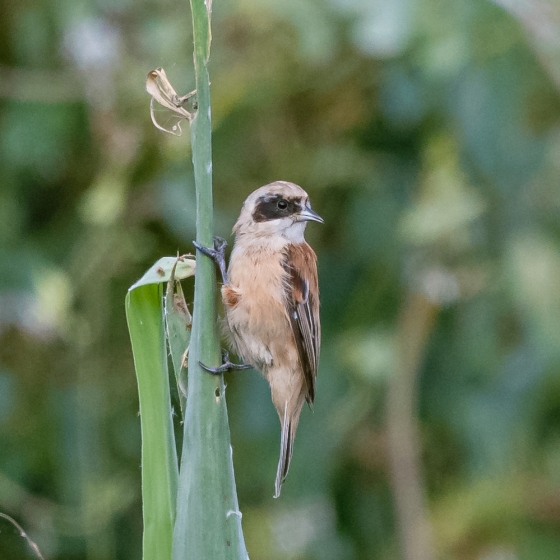Penduline Tit

Introduction
Penduline Tit is a scarce visitor to Britain, with the number of records in the low hundreds.
Several breeding season records, which have included reports of lone males constructing nests, led to hopes of breeding but were ultimately disappointing. Bird ringing has shown that at least some individuals originate in Scandinavia.

Key Stats
Status and Trends
Conservation Status
Population Size
Population Change
Population trends of this scarce species are not routinely monitored.
Distribution
This species is a rare vagrant and was recorded during Bird Atlas 2007–11 as shown on the map. In recent years most records have been in counties south of a line from the Severn to the Wash.
Occupied 10-km squares in UK
or view it on Bird Atlas Mapstore.
or view it on Bird Atlas Mapstore.
European Distribution Map
Distribution Change
This vagrant is too rarely reported to map distribution change.
Change in occupied 10-km squares in the UK
Seasonality
Penduline Tit is a scarce migrant, sometimes encountered in winter.
Weekly pattern of occurrence
The graph shows when the species is present in the UK, with taller bars indicating a higher likelihood of encountering the species in appropriate regions and habitats.

Movement
Britain & Ireland movement
Foreign locations of birds ringed or recovered in Britain & Ireland
Dots show the foreign destinations of birds ringed in Britain & Ireland, and the origins of birds ringed overseas that were subsequently recaptured, resighted or found dead in Britain & Ireland. Dot colours indicate the time of year that the species was present at the location.
- Winter (Nov-Feb)
- Spring (Mar-Apr)
- Summer (May-Jul)
- Autumn (Aug-Oct)

European movements
EuroBirdPortal uses birdwatcher's records, such as those logged in BirdTrack to map the flows of birds as they arrive and depart Europe. See maps for this species here.
The Eurasian-African Migration Atlas shows movements of individual birds ringed or recovered in Europe. See maps for this species here.
Biology
Survival and Longevity
Survival is shown as the proportion of birds surviving from one year to the next and is derived from bird ringing data. It can also be used to estimate how long birds typically live.
View number ringed each year in the Online Ringing Report.
Classification, names and codes
Classification and Codes
- Order: Passeriformes
- Family: Remizidae
- Scientific name: Remiz pendulinus
- Authority: Linnaeus, 1758
- BTO 2-letter code: DT
- BTO 5-letter code: PENTI
- Euring code number: 14900
Alternate species names
- Catalan: teixidor eurasiàtic
- Czech: moudivlácek lužní
- Danish: Pungmejse
- Dutch: Buidelmees
- Estonian: kukkurtihane
- Finnish: pussitiainen
- French: Rémiz penduline
- German: Beutelmeise
- Hungarian: függocinege
- Icelandic: Pungmeisa
- Italian: Pendolino
- Latvian: somzilite
- Lithuanian: eurazine remeza
- Norwegian: Pungmeis
- Polish: remiz (zwyczajny)
- Portuguese: chapim-de-mascarilha
- Slovak: kúdelnícka lužná
- Slovenian: plašica
- Spanish: Pájaro moscón europeo
- Swedish: pungmes
- Welsh: Titw Pendil

